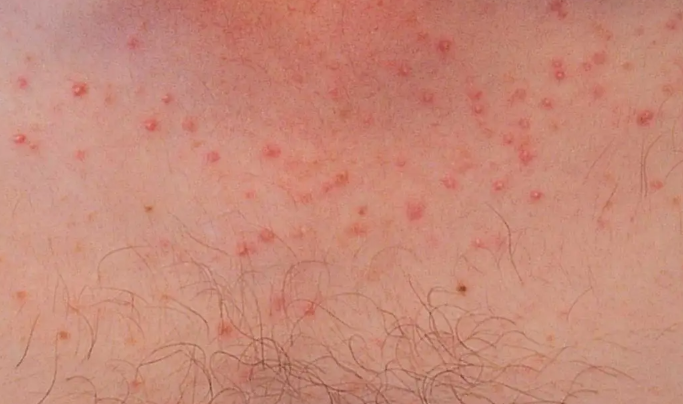Pityrosporum folliculitis, also known as Malassezia folliculitis and fungal acne, is an infection of the hair follicle caused by the fungus Pityrosporum orbiculare (Malassezia furfur). Its ICD-10 code is L73.8.
It primarily affects young and middle-aged individuals with a male to female ratio of 1:3. Predisposing factors include diabetes, follicular occlusion, oily skin, and use of broad-spectrum antibiotics or corticosteroids. It is more common in tropical regions where it manifests as follicular papules, pustules, nodules and cysts.
The primary event may be follicular occlusion followed by increased fungal growth. It is believed that "pomade acne" on the forehead is more likely to be folliculitis caused by Pityrosporum than true acne. Patients may have associated conditions such as pityriasis versicolor, seborrheic dermatitis, or acne. The increased activity of the sebaceous glands in these patients likely provides a lipid-rich environment necessary for fungi to thrive.
Folliculitis should be suspected in young and middle-aged patients with itching and follicular lesions on the body.
- Examination with potassium hydroxide confirms the presence of a significant number of spores and, less frequently, short hyphae.
- Skin biopsy is rarely needed but may demonstrate a high number of spores and, occasionally, hyphae within dilated follicles.
- Acne
- Bacterial Folliculitis
- Pseudomonal Folliculitis
- Eosinophilic Folliculitis
- Gram-negative folliculitis
- Other acneiform eruptions
Discontinuation of systemic antibacterial antibiotics increases the success rate of topical and systemic antifungals. Facial involvement is more persistent, often recurrent, and requires continuous suppression with topical antifungals.
A shampoo containing selenium sulfide is applied during showering for 30 minutes and then rinsed off. This procedure is repeated daily for 3 days to clear the lesions, then once a week as maintenance therapy.
Zinc pyrithione soap is also effective when used during showers. External antifungal agents such as ciclopirox gel or cream or econazole cream are applied overnight each evening for 1 week, then once a week for several weeks and months.
A combination of topical and systemic therapy is the most effective treatment. A combination of ketoconazole shampoo and systemic ketoconazole at a dose of 200 mg daily for 4 weeks has been reported to be 100% effective.
Systemic therapy with itraconazole at a dose of 200 mg for 5 days is also effective. Response to treatment is typically marked by relief of pruritus in the first week, but papules may persist for 3-4 weeks. Recurrences are common if topical maintenance therapy is not continued at regular intervals.
